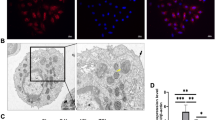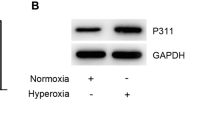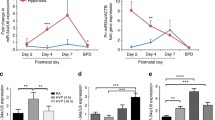Abstract
Background
The mechanism of long time and high-concentration oxygen treatment leading to acute lung injury (ALI) or developmental lung disease in infants is currently unclear. Here we found that compared with the effect of rapamycin, pan-mTOR1/2 inhibitor OSI-027, alleviates hyperoxia-induced lung injury (HILI) by modulation of mTORC2/AKT/TGF-β1 and mTORC1/4E-BP1 signaling in infant rats.
Objective
Infant rats were treated with continuous inhalation of 90% medical oxygen. Normal saline, rapamycin, or OSI-027 was intraperitoneally injected, and the status of lung injury was tested on days 3, 7, and 14. The activation of mTOR/AKT/TGFβ1 and mTORC1/4E-BP1 signaling was confirmed by immunohistochemistry and Western blot analysis in normal and hyperoxia-treated live precision-cut lung tissues. The inhibitory effect of OSI-027 extended to the active state of other proteins implicated in mTOR1/2 signaling was demonstrated in hyperoxia-induced injured lung tissues.
Results
Our data demonstrate that hyperoxia-induced serious lung inflammation and fibrosis. OSI-027 significantly attenuated the pathological process of HILI, inhibit the phosphorylation of the primary downstream targets of mTORC1/C2, and reduce the activation of TGF-β1 signaling.
Conclusions
The results suggest that mTORC2/AKT/TGF-β1 and the rapamycin-insensitive mTORC1/4E-BP1 (Thr37/46) signaling has an important effect during HILI with a potential meaning for the progress of novel anti-hyperoxia-injury strategies.





Similar content being viewed by others
References
Andreollo NA, de Santos EF, Araújo MR, Lopes LR (2012) Rat’s age versus human’s age: what is the relationship? Arq Bras Cir Dig 25:49–51
Bahrami A, Khazaei M, Hasanzadeh M, ShahidSales S, Joudi Mashhad M, Farazestanian M et al (2018) Therapeutic potential of targeting PI3K/AKT pathway in treatment of colorectal cancer: rational and progress. J Cell Biochem 119:2460–2469
Bonniaud P, Margetts PJ, Ask K, Flanders K, Gauldie J, Kolb M (2005) TGF-beta and Smad3 signaling link inflammation to chronic fibrogenesis. J Immunol 175:5390–5395
Dang H-X, Li J, Liu C, Fu Y, Zhou F, Tang L et al (2017) CGRP attenuates hyperoxia-induced oxidative stress-related injury to alveolar epithelial type II cells via the activation of the Sonic hedgehog pathway. Int J Mol Med 40:209–216
Dejust S, Morland D, Bruna-Muraille C, Eymard J-C, Yazbek G, Savoye A-M et al (2018) Everolimus-induced pulmonary toxicity: findings on 18F-FDG PET/CT imaging. Medicine (Baltimore) 97:e12518
Gonzalez-Gonzalez FJ, Chandel NS, Jain M, Budinger GRS (2017) Reactive oxygen species as signaling molecules in the development of lung fibrosis. Transl Res 190:61–68
Gupta M, Hendrickson AEW, Yun SS, Han JJ, Schneider PA, Koh BD et al (2012) Dual mTORC1/mTORC2 inhibition diminishes Akt activation and induces Puma-dependent apoptosis in lymphoid malignancies. Blood 119:476–487
Hamdani S, Thiolat A, Naserian S, Grondin C, Moutereau S, Hulin A et al (2017) Delayed and short course of rapamycin prevents organ rejection after allogeneic liver transplantation in rats. World J Gastroenterol 23:6962–6972
Helmerhorst HJF, Roos-Blom M-J, van Westerloo DJ, de Jonge E (2015) Association between arterial hyperoxia and outcome in subsets of critical illness: a systematic review, meta-analysis, and meta-regression of cohort studies. Crit Care Med 43:1508–1519
Higgins RD, Jobe AH, Koso-Thomas M, Bancalari E, Viscardi RM, Hartert TV et al (2018) Bronchopulmonary dysplasia: executive summary of a workshop. J Pediatr 197:300–308
Hsu H-S, Liu C-C, Lin J-H, Hsu T-W, Hsu J-W, Su K et al (2017) Involvement of ER stress, PI3K/AKT activation, and lung fibroblast proliferation in bleomycin-induced pulmonary fibrosis. Sci Rep 7:14272
Hu Y, Liu J, Wu Y-F, Lou J, Mao Y-Y, Shen H-H et al (2014) mTOR and autophagy in regulation of acute lung injury: a review and perspective. Microbes Infect 16:727–734
Huang S, Yang C, Li M, Wang B, Chen H, Fu D et al (2018) Effect of dual mTOR inhibitor on TGFβ1-induced fibrosis in primary human urethral scar fibroblasts. Biomed Pharmacother 106:1182–1187
Kallet RH, Matthay MA (2013) Hyperoxic acute lung injury. Respir Care 58:123–141
Kang SA, Pacold ME, Cervantes CL, Lim D, Lou HJ, Ottina K et al (2013) mTORC1 phosphorylation sites encode their sensitivity to starvation and rapamycin. Science 341:1236566
Koh HB, Scruggs AM, Huang SK (2016) Transforming growth factor-β1 increases DNA methyltransferase 1 and 3a expression through distinct post-transcriptional mechanisms in lung fibroblasts. J Biol Chem 291:19287–19298
Mitani A, Ito K, Vuppusetty C, Barnes PJ, Mercado N (2016) Restoration of corticosteroid sensitivity in chronic obstructive pulmonary disease by inhibition of mammalian target of rapamycin. Am J Respir Crit Care Med 193:143–153
Nadon AM, Perez MJ, Hernandez-Saavedra D, Smith LP, Yang Y, Sanders LA et al (2014) Rtp801 suppression of epithelial mTORC1 augments endotoxin-induced lung inflammation. Am J Pathol 184:2382–2389
O’Brien NA, McDonald K, Tong L, von Euw E, Kalous O, Conklin D et al (2014) Targeting PI3K/mTOR overcomes resistance to HER2-targeted therapy independent of feedback activation of AKT. Clin Cancer Res 20:3507–3520
Ošt’ádalová I, Babický A (2012) Periodization of the early postnatal development in the rat with particular attention to the weaning period. Physiol Res 61:S1–S7
Özdemir ÖMA, Gözkeser E, Bir F, Yenisey Ç (2014) The effects of resveratrol on hyperoxia-induced lung injury in neonatal rats. Pediatr Neonatol 55:352–357
Özdemir ÖM, Taban Ö, Enli Y, Bir F, Şahin B, Ergin H (2019) The effects of bosentan on hyperoxia-induced lung injury in neonatal rats. Pediatr Int 61:1120–1126
Racanelli AC, Kikkers SA, Choi AMK, Cloonan SM (2018) Autophagy and inflammation in chronic respiratory disease. Autophagy 14:221–232
Reyburn B, Martin RJ, Prakash YS, MacFarlane PM (2012) Mechanisms of injury to the preterm lung and airway: implications for long-term pulmonary outcome. Neonatology 101:345–352
Segura-Ibarra V, Amione-Guerra J, Cruz-Solbes AS, Cara FE, Iruegas-Nunez DA, Wu S et al (2017) Rapamycin nanoparticles localize in diseased lung vasculature and prevent pulmonary arterial hypertension. Int J Pharm 524:257–267
Taha DK, Kornhauser M, Greenspan JS, Dysart KC, Aghai ZH (2016) High flow nasal cannula use is associated with increased morbidity and length of hospitalization in extremely low birth weight infants. J Pediatr 173:50–55
Tian T, Li X, Zhang J (2019) mTOR signaling in cancer and mTOR inhibitors in solid tumor targeting therapy. Int J Mol Sci 20:755
Vogel ER, Britt RD, Trinidad MC, Faksh A, Martin RJ, MacFarlane PM et al (2015) Perinatal oxygen in the developing lung. Can J Physiol Pharmacol 93:119–127
Wang H, Liu Y, Ding J, Huang Y, Liu J, Liu N et al (2020) Targeting mTOR suppressed colon cancer growth through 4EBP1/eIF4E/PUMA pathway. Cancer Gene Ther 27:448–460
Yang H, Jiang X, Li B, Yang HJ, Miller M, Yang A et al (2017) Mechanisms of mTORC1 activation by RHEB and inhibition by PRAS40. Nature 552:368–373
Zaher TE, Miller EJ, Morrow DMP, Javdan M, Mantell LL (2007) Hyperoxia-induced signal transduction pathways in pulmonary epithelial cells. Free Radic Biol Med 42:897–908
Zhao B, Xu S, Dong X, Lu C, Springer TA (2018) Prodomain-growth factor swapping in the structure of pro-TGF-β1. J Biol Chem 293:1579–1589
Acknowledgements
This study was supported by a Grant from the Basic And Frontier Research Project From Chongqing Science And Technology Commission, Chongqing, China (cstc2018jcyjAX0046).
Author information
Authors and Affiliations
Contributions
Conceptualization, writing-review, and editing: HD and LL; Data curation and investigation: LL and ML; Formal analysis, funding acquisition, methodology and software: HD, PW, LL, YL, ML; Writing-original draft: HD; Project administration: HD; Resources and visualization: LL, ML. Supervision: HD; Validation: LL and ML.
Corresponding author
Ethics declarations
Conflict of interest
The authors have declared that no conflict of interest exists.
Ethical approval
All animal experiments were performed with local ethical committee approval (Ethics Committee of Chongqing Medical University, Chongqing, China). This study also followed the National Institutes of Health guide for the care and use of Laboratory Animals (NIH Publications No. 8023, revised 1978).
Additional information
Publisher's Note
Springer Nature remains neutral with regard to jurisdictional claims in published maps and institutional affiliations.
Rights and permissions
About this article
Cite this article
Long, L., Liang, M., Liu, Y. et al. OSI-027 alleviates rapamycin insensitivity by modulation of mTORC2/AKT/TGF-β1 and mTORC1/4E-BP1 signaling in hyperoxia-induced lung injury infant rats. Mol. Cell. Toxicol. 17, 245–256 (2021). https://doi.org/10.1007/s13273-021-00131-y
Accepted:
Published:
Issue Date:
DOI: https://doi.org/10.1007/s13273-021-00131-y




